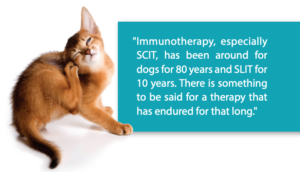Allergy Immunotherapy in the Atopic Dog and Cat-Still a Viable Option
“I want to know what my pet is allergic to!”
We hear that on a daily basis in veterinary clinics all over the country. In veterinary medicine we are fortunate to have methods to determine pets’ allergies intradermal skin testing or serum testing. The real question is, “what to do with that information once I have it?” Most owners don’t go beyond that step. It is the veterinary professional that has to devise an individual plan for addressing these allergies. Even before doing that, the pet needs to be confirmed that he/she IS, in fact, ATOPIC! Sounds silly but the diagnosis of atopy is not made by allergy testing, no matter which method is chosen, but by the patient’s history, age of onset of symptoms, breed of dog, and seasonality. Other differentials that may mimic atopy including ectoparasites such as scabies, flea allergy, Cheyletiella, and food allergy (if the symptoms are nonseasonal) need to be excluded before the diagnosis of atopy is made. Once the veterinarian is confident the patient is atopic, allergy testing can be performed to determine which allergens need to be included in either an injectable allergy solution (SCIT) or sublingual allergy solution (SLIT).
With the advent of newer, faster acting oral medications, why even consider injectable or sublingual immunotherapy for dogs?
- Allergy immunotherapy (AIT) is the only method of treatment that can help clinical signs/symptoms of canine atopy, actually CHANGE THE COURSE OF THE DISEASE and in some patients even elicit a “cure”.
- Injectable (SCIT) immunotherapy in dogs has been around since 1941. Numerous studies have confirmed a 60–70% efficacy with minimal adverse effects (<1%).
- When used in concert with adjunctive medications for atopy, AIT can reduce accompanying drug use and consequently laboratory monitoring that is necessary with those medications.
- If it is determined that the owner or pet cannot be administered injections, then sublingual immunotherapy (SLIT) can be undertaken with the same success rate as SCIT. SLIT rarely has adverse effects, the most common being oral pruritis/redness after dosing.
- SLIT can be effective in 3–6 months, SCIT may take 6–9 months with a one-year trial of either suggested to determine a complete response.
- If a dog fails SCIT therapy, there is a 50% chance he/she will respond to SLIT therapy.
- Since allergy is a dynamic process and changes daily, adjunctive medications may be used for any acute flareups while on SCIT or SLIT without any contraindications.
- By controlling the underlying allergy with SCIT or SLIT, there is less cost involved by having to use medications to treat accompanying bacterial or yeast pyodermas and less chance of antimicrobial resistance.
Atopy in dogs and humans share many similarities, unlike atopy in the cat
Atopic cats can present with many different clinical signs such as eosinophilic granuloma complex lesions, indolent ulcers, miliary dermatitis, otitis , seborrhea, and pruritus without lesions. Unlike dogs or humans who show symptoms of atopy at a young age, at least 20% of cats may start with symptoms after the age of 7 years. Unfortunately, and perhaps because atopic cats are unlike dogs or humans, little research has been done in the pathogenesis of atopy in cats.
It is estimated that atopy occurs in 12% of cats with Abyssinian and Devon Rex breeds predisposed. In my 30-year dermatology practice in the Midwest, atopy occurred more often in orange colored cats or orange colored-containing cats such as calico’s and tortoise shell cats (anecdotal observation but the numbers support it). Although we saw atopy in all colors of cats, orange colored cats far outnumbered the rest! In the past, long acting glucocorticoid injections were routinely used for allergic symptoms in cats. Studies show that in some cats these long-acting steroid injections can cause cardiomyopathy or predispose to diabetes. Other alternatives for treatment include oral short-acting steroids, antihistamines, or oral modified cyclosporine liquid. As everyone knows, not every client can “pill” a cat and the aforementioned medications are all orally administered! Antihistamines are a category of medication that are bitter tasting as is cyclosporine liquid and many cats after the first dose will hypersalivate resulting in poor compliance. It may be much easier for an owner to administer a once weekly subcutaneous allergy immunotherapy injection (SCIT) than a once daily or twice daily oral medication.
It is surprising to see how many owners choose to pursue SCIT for their atopic cat after explaining the options for treating atopy. Of course, before intradermal or serum testing to determine which allergens are to be included in the SCIT, differentials that mimic atopy such as food allergy, dermatophytosis, and ectoparasites need to be ruled out. 1. SCIT in cats has a 50–78% good response in the few studies that have been reported. SLIT is an emerging therapy for atopic cats with new studies on the horizon. 2. Once weekly SCIT prevents the owner from having to administer daily oral medications and prevents the potential adverse effects of long-term administration of those medications. 3. Overall SCIT is cost effective as the owner is administering the injections and no subsequent laboratory monitoring is necessary as with some of the oral pharmaceuticals. 4. Anecdotally, cats seem to do better on SCIT than dogs (approximately 75% success rate in my practice) as their environment is more controlled (most live indoors) and they are fastidious groomers, “grooming off” dust mites, pollen, etc. Immunotherapy, especially SCIT, has been around for dogs for 80 years and SLIT for 10 years. There is something to be said for a therapy that has endured for that long. There has been ample opportunity for evaluating its use as well as identifying any potential adverse effects. Knowing that immunotherapy in dogs can halt the progression of the disease (and hopefully in cats as well) thereby limiting the use of medications with potential adverse effects makes it a viable option for atopy in these species.
- Mueller RS, et al. Allergen immunotherapy in people, dogs, cats and horses-differences, similarities and research needs. Allergy 2018;73:1989–1999.
- Mueller RS, et al. Allergen immunotherapy in people, dogs, cats and horses-differences, similarities and research needs. Allergy 2018;73:1989–1999.3. Gedon NK, Mueller RS.
- Atopic dermatitis in cats and dogs: a difficult disease for animals and owners. BMC 2018;8:41.
- Marsella R, DeBenedetto A. Atopic dermatitis in animals and people: an update and comparative review. Vet Sci 2017 Sep;4(3)37.
- DeBoer DJ. Sublingual immunotherapy for atopic dermatitis. Clinicians Brief 2013: 13–15.
- DeBoer DJ. Sublingual immunotherapy-a new option for allergy patients. Vet Med. January 2014; 21–28


